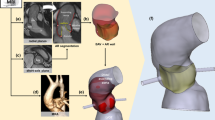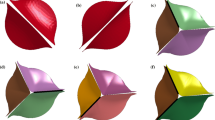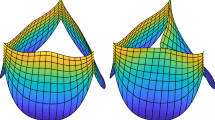Abstract
A bicuspid aortic valve (BAV) is a congenital cardiac disorder where the valve consists of only two cusps instead of three, as in a normal tricuspid valve (TAV). Although 97 % of BAVs include asymmetric cusps, little or no prior studies have investigated the blood flow through a three-dimensional BAV and root. The aim of the present study was to characterize the effect of asymmetric BAV on the blood flow using fully coupled fluid–structure interaction (FSI) models with improved boundary conditions and tissue properties. This study presents four FSI models, including a native TAV, asymmetric BAVs with or without a raphe, and an almost symmetric BAV. Cusp tissue is composed of hyperelastic finite elements with collagen fibres embedded in the elastin matrix. A full cardiac cycle is simulated by imposing the same physiological blood pressures for all the TAV and BAV models. The latter have significantly smaller opening areas compared with the TAV. Larger stress values were found in the cusps of BAVs with fused cusps, at both the systolic and diastolic phases. The asymmetric geometry caused asymmetric vortices and much larger flow shear stress on the cusps which could be a potential initiator for early valvular calcification of BAVs.








Similar content being viewed by others
References
Balachandran K, Sucosky P, Yoganathan AP (2011) Hemodynamics and mechanobiology of aortic valve inflammation and calcification. Int J Inflamm. doi:10.4061/2011/263870
Barker AJ, Lanning C, Shandas R (2010) Quantification of hemodynamic wall shear stress in patients with bicuspid aortic valve using phase-contrast MRI. Ann Biomed Eng 38:788–800
Bellhouse BJ (1969) Velocity and pressure distributions in the aortic valve. J Fluid Mech 37:587–600
Borazjani I, Iman G, Sotiropoulos F (2010) High-resolution fluid–structure interaction simulations of flow through a bi-leaflet mechanical heart valve in an anatomic aorta. Ann Biomed Eng 38:326–344
Braverman AC, Güven H, Beardslee MA, Makan M, Kates AM, Moon MR (2005) The bicuspid aortic valve. Curr Probl Cardiol 30:470–522
Chandran KB, Vigmostad SC (2013) Patient-specific bicuspid valve dynamics: overview of methods and challenges. J Biomech 46:208–216
Chandra S, Rajamannan N, Sucosky P (2012) Computational assessment of bicuspid aortic valve wall-shear stress: implications for calcific aortic valve disease. Biomech Model Mechanobiol 11:1085–1096
Conti CA, Della Corte A, Votta E, Del Viscovo L, Bancone C, De Santo LS, Redaelli A (2010) Biomechanical implications of the congenital bicuspid aortic valve: a finite element study of aortic root function from in vivo data. J Thorac Cardiovasc Surg 140:890–896
Faggiano E, Antiga L, Puppini G, Quarteroni A, Luciani GB, and Vergara C (2012) Helical flows and asymmetry of blood jet in dilated ascending aorta with normally functioning bicuspid valve. Biomech. Model. Mechanobiol, doi:10.1007/s10237-012-0444-1
Gundiah N, Kam K, Matthews PB, Guccione J, Dwyer HA, Saloner D, Chuter TA, Guy TS, Ratcliffe MB, Tseng EE (2008) Asymmetric mechanical properties of porcine aortic sinuses. Ann Thorac Surg 85:1631–1638
Gundiah N, Matthews PB, Karimi R, Azadani A, Guccione J, Guy TS, Saloner D, Tseng EE (2008) Significant material property differences between the porcine ascending aorta and aortic sinuses. J Heart Valve Dis 17:606–613
Haj-Ali R, Marom G, Ben Zekry S, Rosenfeld M, Raanani E (2012) A general three-dimensional parametric geometry of the native aortic valve and root for biomechanical modeling. J Biomech 45:2392–2397
Hong T, Kim CN (2011) A numerical analysis of the blood flow around the bileaflet mechanical heart valves with different rotational implantation angles. J Hydrodyn Ser B 23:607–614
Jermihov P, Jia L, Sacks MS, Gorman R, Gorman J, Chandran K (2011) Effect of geometry on the leaflet stresses in simulated models of congenital bicuspid aortic valves. Cardiovasc Eng Technol 2:48–56
Katayama S, Umetani N, Hisada T, Sugiura S (2012) Bicuspid aortic valves undergo excessive strain during opening: a simulation study. J Thorac Cardiovasc Surg. doi:10.1016/j.jtcvs.2012.05.032
Kim HS (2009) Nonlinear multi-scale anisotropic material and structural models for prosthetic and native aortic heart valves. PhD thesis, Georgia Institute of Technology, Atlanta, GA, USA
Marom G, Haj-Ali R, Raanani E, Schäfers HJ, Rosenfeld M (2012) A fluid-structure interaction model of coaptation in fully compliant aortic valves. Med Biol Eng Comput 50:173–182
Missirlis YF, Chong M (1978) Aortic valve mechanics—part 1: material properties of natural porcine aortic valves. J Bioengrg 2:287–300
Richards KE, Deserranno D, Donal E, Greenberg NL, Thomas JD, Garcia MJ (2004) Influence of structural geometry on the severity of bicuspid aortic stenosis. Am J Physiol Heart Circ Physiol 287:H1410–H1416
Robicsek F, Thubrikar MJ, Cook JW, Fowler B (2004) The congenitally bicuspid aortic valve: how does it function? why does it fail? Ann Thorac Surg 77:177–185
Saikrishnan N, Yap CH, Milligan NC, Vasilyev NV, Yoganathan AP (2012) In vitro characterization of bicuspid aortic valve hemodynamics using particle image velocimetry. Ann Biomed Eng 40:1760–1775
Sun L, Chandra S, and Sucosky P (2012) Ex vivo evidence for the contribution of hemodynamic shear stress abnormalities to the early pathogenesis of calcific bicuspid aortic valve disease. PLoS one 7: e48843
Thubrikar M (1990) The Aortic Valve. Boca Raton, FL, USA: CRC Press, pp 91–92, 158-160
Vergara C, Viscardi F, Antiga L, Luciani GB (2012) Influence of bicuspid valve geometry on ascending aortic fluid dynamics: a parametric study. Artif Organs 36:368–378
Viscardi F, Vergara C, Antiga L, Merelli S, Veneziani A, Puppini G, Faggian G, Mazzucco A, Luciani GB (2010) Comparative finite element model analysis of ascending aortic flow in bicuspid and tricuspid aortic valve. Artif Organs 34:1114–1120
Wang SH, Lee LP, Lee JS (2001) A linear relation between the compressibility and density of blood. J Acoust Soc Am 109:390–396
Weiler M, Yap CH, Balachandran K, Padala M, Yoganathan AP (2011) Regional analysis of dynamic deformation characteristics of native aortic valve leaflets. J Biomech 44:1459–1465
Weinberg EJ, Mofrad MRK (2008) A multiscale computational comparison of the bicuspid and tricuspid aortic valves in relation to calcific aortic stenosis. J Biomech 41:3482–3487
Weston MW, LaBorde DV, Yoganathan AP (1999) Estimation of the shear stress on the surface of an aortic valve leaflet. Ann Biomed Eng 27:572–579
Yap CH, Saikrishnan N, Tamilselvan G, Vasiliyev NV, Yoganathan AP (2012) The congenital bicuspid aortic valve can experience high frequency unsteady shear stresses on its leaflet surface. Am J Physiol Heart Circul Physiol 303:H721–H731
Yap CH, Saikrishnan N, Tamilselvan T, Yoganathan AP (2012) Experimental measurement of dynamic fluid shear stress on the aortic surface of the aortic valve leaflet. Biomech Model Mechanobiol 11:171–182
Yap CH, Saikrishnan N, Yoganathan AP (2012) Experimental measurement of dynamic fluid shear stress on the ventricular surface of the aortic valve leaflet. Biomech Model Mechanobiol 11:231–244
Yoganathan A, Chandran K, Sotiropoulos F (2005) Flow in prosthetic heart valves: state-of-the-art and future directions. Ann Biomed Eng 33:1689–1694
Acknowledgments
This work was partially supported by a grant from the Nicholas and Elizabeth Slezak Super Center for Cardiac Research and Biomedical Engineering at Tel Aviv University. Rami Haj-Ali acknowledges the support from the EU Marie-Curie IRG grant.
Author information
Authors and Affiliations
Corresponding author
Rights and permissions
About this article
Cite this article
Marom, G., Kim, HS., Rosenfeld, M. et al. Fully coupled fluid–structure interaction model of congenital bicuspid aortic valves: effect of asymmetry on hemodynamics. Med Biol Eng Comput 51, 839–848 (2013). https://doi.org/10.1007/s11517-013-1055-4
Received:
Accepted:
Published:
Issue Date:
DOI: https://doi.org/10.1007/s11517-013-1055-4




